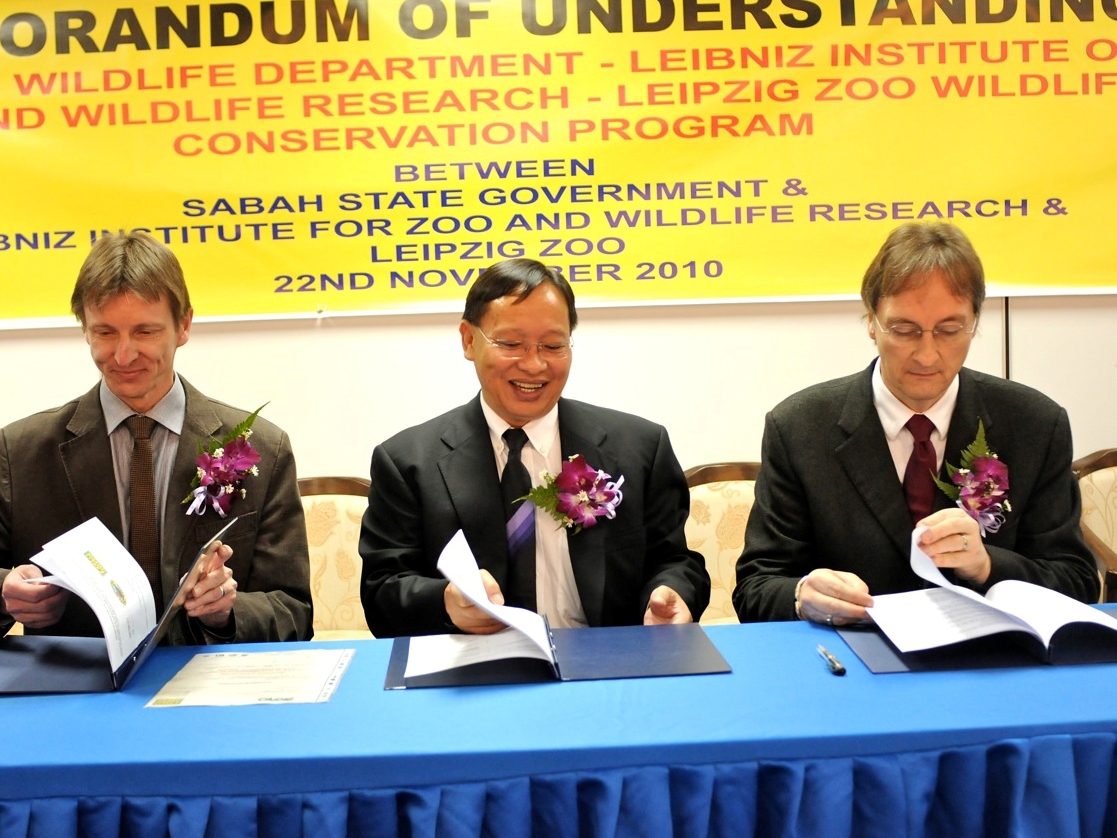On Monday, 22nd November 2010, a Memorandum of Understanding (MoU) was signed between the Leibniz Institute for Zoo and Wildlife Research (IZW), the Leipzig Zoo (LZ) and the State Government of Sabah, represented by the Sabah Wildlife Department (SWD), combining international expertise and resources in order to prevent further losses of biodiversity.
Sabah, the Malaysian Federal State on the island of Borneo, is internationally renowned as one of the world’s most important hotspots of biodiversity, including the world’s oldest rainforests with its associated fauna and flora. According to the IUCN, Sabah’s large animals – such as the Sumatran rhino, the Borneo pygmy elephant, the Sunda clouded leopard and the orang-utan – are seriously threatened and face an extinction crisis.
For several years already, the SWD and the IZW have closely cooperated to conduct research on the conservation needs of threatened Bornean carnivores. This initiative has raised international attention through the re-discovery of the hairy-nosed otter in Sabah after over 100 years, and the first videos ever taken of the Sunda clouded leopard or the endangered otter civet. With the MoU signed today, this partnership will expand its remit to other Bornean flagship species such as the Sumatran rhino.
The German Federal Ministry of Education and Research (BMBF) has agreed to finance the first project in this collaboration, an attempt to breed the Sabah rhino. The Sabah rhino (Dicerorhinus sumatrensis harrissoni) is a subspecies of the Sumatran rhino and primarily lives in the lowland rain forests of Sabah. It is the smallest rhino and with less than 50 individuals it is the most endangered rhino species on our planet after the Northern white rhino in Africa. Sabah Wildlife Department, in cooperation with the Borneo Rhino Alliance (BORA) and WWF Malaysia, started a comprehensive conservation programme to protect and breed these impressive rhinos. The Bornean Rhino Rescue Programme is jointly funded by the Malaysian Government through the Sabah Development Corridor as well as Yayasan Sime Darby. “Yayasan Sime Darby has been very instrumental in initialising the Rhino Rescue Programme here in Sabah”, said Dr Laurentius Ambu, Director of the Sabah Wildlife Department. “The IZW will contribute to this programme with its scientific expertise in assisted reproduction techniques, and the Leipzig Zoo will contribute their skills in animal husbandry and will train our local staff in handling the animals” added Dr Laurentius Ambu. The IZW is known for its scientifically based approach to conservation research. “With the financial support from the German Federal Ministry of Research and Education, which has recently been granted for the Sabah rhino project, we are able to implement research and to support the local breeding programme with high tech equipment and a team of experts from Germany and Australia” , said Prof Dr Heribert Hofer, Director of the IZW. Dr Jörg Junhold, the Director of Leipzig Zoo adds, “our zoo will send skilled keepers to Sabah in order to exchange their experiences in captive management, enrichment techniques and in enclosure design with the local keepers in Lok Kawi and in Tabin. On top of this we will inform more than two million visitors annually about Sabah’s outstanding rhino conservation project in our tropical hall ‘Gondwanaland’, which will open in 2011." The IZW and Leipzig Zoo are closely collaborating with dan pearlman, a German brand and experience architecture firm, which will help to promote the Sabah rhino project in Germany.
The cooperation between the SWD, the IZW and LZ was initiated in November 2009 during a visit of the directors of the two German institutions in Sabah. The parties agreed to cooperate, improve, develop and implement strategies in the fields of wildlife conservation research, wildlife veterinary medicine and zoo management science. Shortly after their visit, the experts from both organisations performed a reproductive assessment of a captive male and female rhino, conducted by a specialist team of wildlife veterinarian scientists led by Dr Thomas Hildebrandt from the IZW and Prof Chris Walzer from the Veterinary University of Vienna. In January 2011, the next step of the programme of reproductive research will take place. “A female rhino, recently transferred to Tabin, will be stimulated with hormones and artificially inseminated. The resulting embryos will be collected and frozen in liquid nitrogen. Her genes are very valuable for the survival of the species, but she is unfortunately too old to breed naturally.” explains Dr Petra Kretzschmar from the IZW.
Acting swiftly is necessary for the success of the Sabah rhino conservation programme and its associated research. Large areas of rhino habitat have disappeared for palm oil production which has fragmented the landscape, making reproductive contact between individuals difficult. The Rhino and Forest Fund, a German-based NGO, will supplement the conservation research programme of the IZW and the Leipzig Zoo, restoring and reconnecting degraded and fragmented forest land through reforestation. The aim is to increase habitat and reconnect patches of rainforest, enabling the movements of individuals and the continuation of breeding of isolated populations. The project is conducted in cooperation with the Sabah Forestry Department. It is believed that this approach, including cutting edge scientific know-how from the IZW, training and preparation from a prominent zoo, a reforestation programme and a public awareness campaign is unique and necessary for the rescue of one of the most endangered species on earth.


